Click on images to enlarge
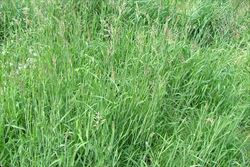
infestation in spring (Photo: Sheldon Navie)
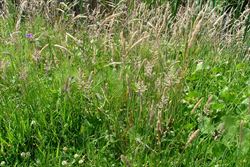
infestation in summer (Photo: Sheldon Navie)
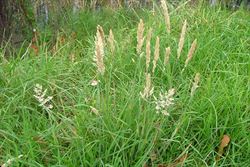
habit (Photo: Sheldon Navie)
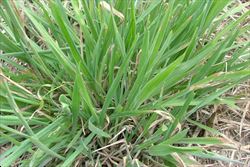
tufted softly hairy leaves (Photo: Sheldon Navie)
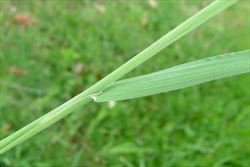
close-up of hairy stem and base of leaf blade (Photo: Sheldon Navie)
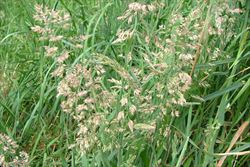
seed-heads (Photo: Sheldon Navie)
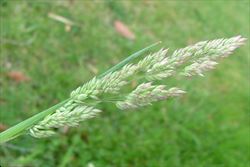
young seed-head (Photo: Sheldon Navie)
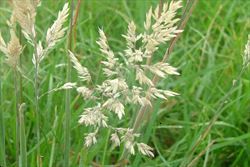
seed-head during flowering (Photo: Sheldon Navie)
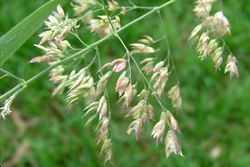
close-up of flower spikelets (Photo: Sheldon Navie)
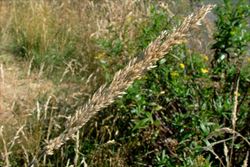
mature seed-head (Photo: Sheldon Navie)
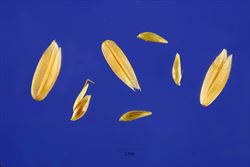
close-up of seeds (Photo: Steve Hurst at USDA PLANTS Database)
Scientific Name
Holcus lanatus L.
Family
Gramineae (South Australia)Poaceae (Queensland, New South Wales, the ACT, Victoria, Tasmania, Western Australia and the Northern Territory)
Common Names
common velvet grass, common velvetgrass, creeping velvetgrass, fog grass, meadow soft grass, meadow softgrass, mesquite, mesquite grass, soft meadow grass, tufted soft grass, tufted softgrass, velvet grass, velvetgrass, woolly soft grass, Yorkshire fog
Origin
Native to northern Africa (i.e. Algeria, Morocco and Tunisia), the Azores, the Madeira Islands, the Canary Islands, Europe and western Asia (i.e. Lebanon, Turkey, Azerbaijan, Georgia and southern Russia).
Cultivation
An ornamental cultivar of this species with variegated leaves in sometimes grown in gardens. It is known as variegated velvet grass (Holcus lanatus 'Variegatus').
Naturalised Distribution
This species is very widely naturalised in southern and eastern Australia. It is most common in eastern and southern New South Wales, the ACT, Victoria, Tasmania, south-eastern South Australia and south-western Western Australia. Also present in other parts of South Australia and in south-eastern and central Queensland.
Widely naturalised overseas in southern Africa, tropical Asia, La Réunion, New Zealand, Hawaii, the USA, Canada, Central America and South America.
Habitat
A weed of pastures, open woodlands, grasslands, watercourses, swamps, wetlands, crops, roadsides, disturbed sites, waste areas, lawns and gardens in the temperate regions of Australia.
Habit
A tufted long-lived (i.e. perennial) grass growing up to 1 m tall.
Distinguishing Features
-
a long-lived tufted grass growing up to 1 m tall.
-
its elongated leaves are softly hairy and where the leaf sheath meets the leaf blade there is a small membranous structure topped with tiny hairs.
-
its seed-heads (5-17 cm long and up to 5 cm wide) are quite variable in shape and colour, depending on their age.
-
young seed-heads are greenish or pinkish-purple tinged and are relatively narrow with closely held branches.
-
they turn whitish in colour and become quite open with many spreading branches when in flower.
-
these seed-heads consist of numerous small flower spikelets (3-4 mm long) that turn straw-coloured when mature.
Stems and Leaves
The leaves are softly hairy, with a leaf sheath that encloses the stem and a spreading leaf blade. The leaf blades are flat (up to 10 mm wide) with entire margins and pointed tips (ie. acute apices). Where the leaf sheath meets the leaf blade there is a small membranous structure (i.e. ligule) 2-4 mm long topped with tiny hairs about 0.3 mm long.
Flowers and Fruit
The seed-heads (5-17 cm long and up to 5 cm wide) are quite variable in shape and colour, depending on their maturity. Young seed-heads are greenish or pinkish-purple tinged and are relatively narrow with closely held branches (i.e. they are contracted). When in full flower they turn whitish in colour and become quite open in appearance, with several spreading branches (i.e. they form open panicles). As they mature they turn straw-coloured and once again their branches become closely held to the stem (i.e. they become contracted). These seed-heads are made up of numerous small flower spikelets (4-5 mm long). Each of these flower spikelets consists of a pair of bracts (i.e. glumes) 3-4 mm long and two tiny flowers (i.e. florets). The lower floret has both male and female parts (i.e. it is bisexual), while the upper floret has only male parts and does not produce a seed. Flowering occurs during spring and summer.
Reproduction and Dispersal
This species reproduces mainly by seed, but may also spread vegetatively when its creeping stems develop roots at their joints (i.e. produce adventitious roots and their nodes).
Yorkshire fog (Holcus lanatus) seeds may be spread by wind and water movement, by adhering to clothing, animals and vehicles, in mud and contaminated soil, in dumped garden waste, and in contaminated agricultural produce (e.g. fodder).
Environmental Impact
Yorkshire fog (Holcus lanatus) is regarded as an environmental weed in Victoria, the ACT, New South Wales, Tasmania, South Australia and Western Australia. This species is most invasive in moist sites, such as along watercourses, in swamps and around the margins of freshwater wetlands, in the temperate regions of Australia. However, it tolerates a wide range of conditions and is also a weed of roadsides, disturbed sites, waste areas, pastures, open woodlands and grasslands.
In New South Wales, Yorkshire fog (Holcus lanatus) is most invasive on fertile soils in cooler and wetter areas, such as on the tablelands. It is listed as an environmental weed in the wider Sydney and Blue Mountains region and is considered to be a threat to a number of endangered plant communities and plant species in this state. For example, it poses a threat to "tableland basalt forests" in the Sydney Basin and South Eastern Highlands bioregions and is a weed of "montane peatlands and swamps", both of which are listed as endangered ecological communities in New South Wales.
It is also one of a handful of invasive exotic grasses that are thought to be the most serious threat to the survival of the endangered Tarengo leek orchid (Prasophyllum petilum) in grasslands and grassy woodlands of the Southern Tablelands of New South Wales and the ACT. It has invaded the few remaining sites where this ground orchid survives in the wild, apparently without any significant disturbance, and has become more prominent at these sites in recent times. In the ACT, Yorkshire fog (Holcus lanatus) is a threat to endangered "natural temperate grasslands" and is a common weed of sub-alpine grasslands and woodlands in Namadgi National Park.
In Victoria, this species is thought to pose a very serious threat to one or more plant communities and is listed as an important weed of plains swampy woodlands in the Warrnambool Plains bioregion. Yorkshire fog (Holcus lanatus) appears on numerous local environmental weed lists in this state and is one of the main exotic weeds that is threatening the endangered gaping leek-orchid (Prasophyllum correctum) in southern Victoria.
In South Australia, Yorkshire fog (Holcus lanatus) is most common in wet localities in populated areas. It tends to invade the margins of wetlands and can become more prevalent within wetland areas if water levels decrease. During one study, Yorkshire fog (Holcus lanatus) was found to be the most commonly recorded weed species in wetlands on the Fleurieu Peninsula, being present in about 80% of wetlands that were surveyed. Invasive weeds were also found to be the most severe threat to wetland biodiversity during this study.
Yorkshire fog (Holcus lanatus) also grows in swamps, along creek edges, and in disturbed areas from Perth to Albany in south-western Western Australia. It is regarded as a common wetland weed in southern Western Australia and was ranked as a moderately important species in the Environmental Weed Strategy of Western Australia.
Legislation
Not declared or considered noxious by any state government authorities.
Management
For information on the management of this species see the following resources:
- the Yorkshire fog grass page on the South Coast Weeds website at http://www.esc.nsw.gov.au/Weeds/index.asp.
Similar Species
Yorkshire fog (Holcus lanatus) can be confused with annual fog (Holcus setosus), Holcus setiger and creeping fog (Holcus mollis). These species can be distinguished by the following differences:
- Yorkshire fog (Holcus lanatus) is long-lived (i.e. perennial) tufted plant with softly hairy stems and leaves. Its flower spikelets are awnless or have very short awns less than 1 mm long.
- annual fog (Holcus setosus) is a short-lived (i.e. annual) tufted plant with softly hairy stems and leaves. Its flower spikelets have more prominent awns (1-3 mm long).
- Holcus setiger is a short-lived (i.e. annual) tufted plant with softly hairy stems and leaves. Its flower spikelets have more prominent awns (3-6 mm long).
- creeping fog (Holcus mollis) is a long-lived (i.e. perennial) plant with creeping underground stems (i.e. rhizomes). It can be either hairy or hairless (i.e. glabrous) and its flower spikelets have more prominent awns (1-5 mm long).

